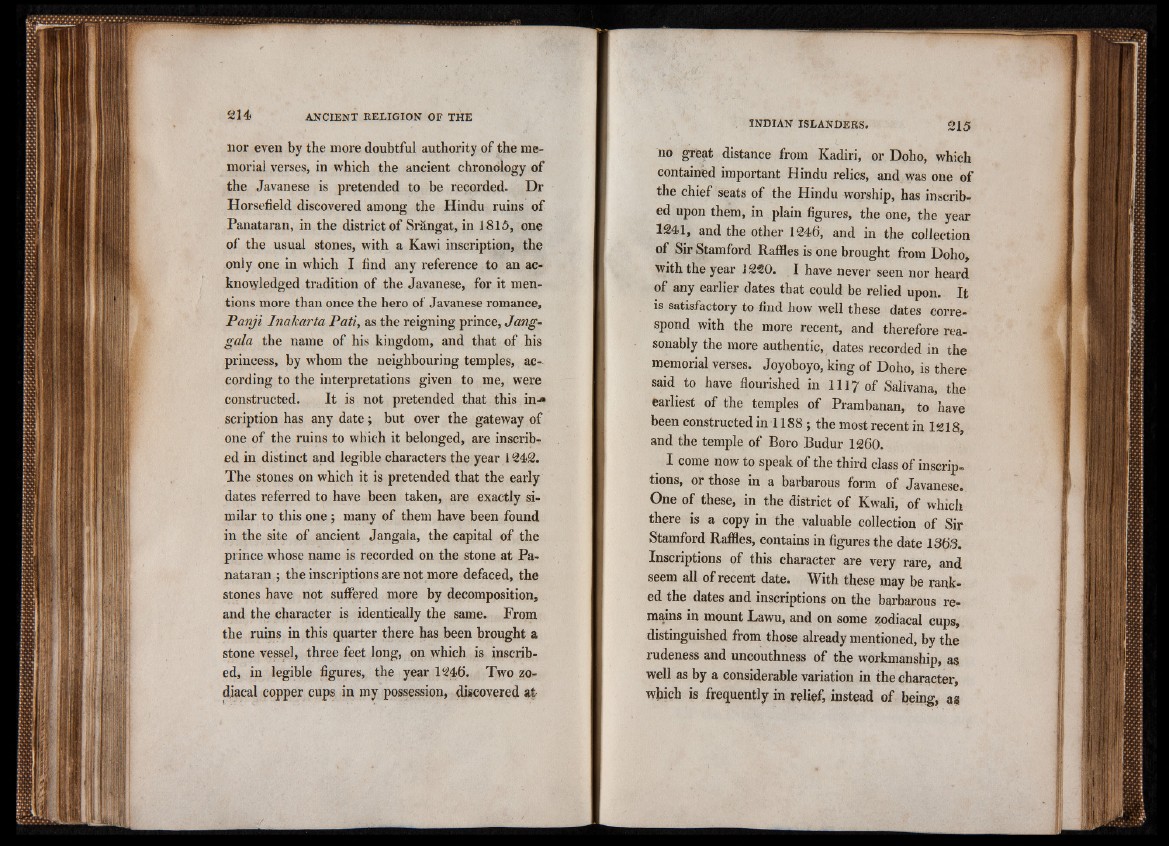
nor even by the more doubtful authority of the memorial
verses, in which the ancient chronology of
the Javanese is pretended to be recorded. Dr
H orsefield discovered among the Hindu ruins of
Panataran, in the district of Srangat, in 1815, one
of the usual stones, with a Kawi inscription, the
only one in which I find any reference to an acknowledged
tradition of the Javanese, for it mentions
more than once the hero of Javanese romance,
Panji Inakarta Pati, as the reigning prince, Jang-
gala the name of his kingdom, and that of his
princess, by whom the neighbouring temples, ac-.
cording to the interpretations given to me, were
constructed. It is not pretended that this in-*
scription has any date; but over the gateway of
one of the ruins to which it belonged, are inscribed
in distinct and legible characters the year 1242.
The stones on which it is pretended that the early
dates referred to have been taken, are exactly similar
to this one ; many of them have been found
in the site of ancient Jangala, the capital of the
prince whose name is recorded on the stone at Panataran
; the inscriptions are not more defaced, the
stones have not suffered more by decomposition,
and the character is identically the same. From
the ruins in this quarter there has been brought a
stone vessel, three feet long, on which is inscribed,
in legible figures, the year 1246. Two zodiacal
copper cups in my possession, discovered at
no great distance from Kadiri, or Doho, which
contained important Hindu relics, and was one of
the chief seats of the Hindu worship, has inscribed
upon them, in plain figures, the one, the year
1241, and the other 1246, and in the collection
of Sir Stamford Raffles is one brought from Doho,
with the year 1220. I have never seen nor heard
of any earlier dates that could be relied upon. It
is satisfactory to find how well these dates correspond
with the more recent, and therefore reasonably
the more authentic, dates recorded in the
memorial verses. Joyoboyo, king of Doho, is there
said to have flourished in 1 1 1 7 of Saiivana, the
earliest of the temples of Prambanan, to have
been constructed in 1188; the most recent in 1218,
and the temple of Boro Budur 1260.
I come now to speak of the third class of inscriptions,
or those in a barbarous form of Javanese.
One of these, in the district of Kwali, of which
there is a copy in the valuable collection of Sir
Stamford Raffles, contains in figures the date 1363.
Inscriptions of this character are very rare, and
seem all of recent date. With these may be ranked
the dates and inscriptions on the barbarous remains
in mount Lawu, and on some zodiacal cups,
distinguished from those already mentioned, by the
rudeness and uncouthness of the workmanship, as
well as by a considerable variation in the character,
which is frequently in relief, instead of being, as;